Wildlife Trade 101
Wildlife trade is big business, with wild plants, animals, and products made from them sold around the globe, legally and illegally. It’s also a leading cause of the planet’s accelerating biodiversity crisis and resultant ecosystem collapse.
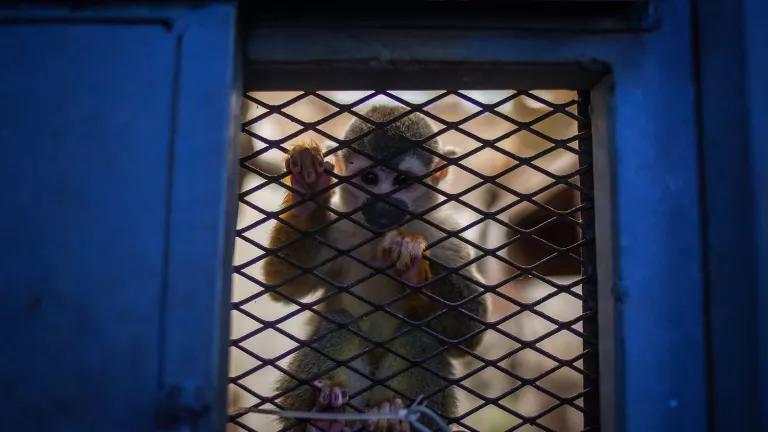
A rescued common squirrel monkey, a victim of animal trafficking, in Bogota, Colombia
Jump to Section
- What Is Wildlife Trade?
- Why Is Wildlife Trade a Problem?
- Examples of Highly Trafficked Species
- Stopping Wildlife Crime
What Is Wildlife Trade?
Wildlife trade means taking and selling dead or living plants and animals and the products derived from them. Some of this is legal. But much of it isn’t. Indeed, the U.S. State Department estimates that wildlife trafficking is the third-largest type of illegal trade, after drugs and weapons, with the value of smuggled goods totaling about $10 billion a year.
Why do people covet these species? Animals such as Asian otters,squirrel monkeys, and African grey parrots may be wanted as pets. Their meat may be in demand as a delicacy—in many countries, the rarer an animal, the greater people’s desire to eat it. (Hence the hunger for pangolin meat and shark fins.) Animal skins and hides, such as those from giraffes or crocodiles, may be sought for rugs or as leather for handbags or shoes. Their body parts may also be coveted for use in traditional Asian medicines (pangolin scales, sun bear bile, tiger bones) and as status symbols or decor (elephant ivory, animal trophies). Plants, including wood from trees that are already excessively logged, are in demand for furniture or ornamental or medicinal purposes.
The Convention on International Trade in Endangered Species of Wild Fauna and Flora (CITES) is a treaty that regulates the international trade of 5,800 animal and 30,000 plant species via a permitting system. CITES offers three levels of protection, with Appendix I being the highest, banning all international commercial trade in a species. But even with 183 members or parties to CITES, including the United States, China, and South Africa, the trade agreement’s restrictions are not enough to protect vulnerable populations.
Why Is Wildlife Trade a Problem?
We are currently experiencing an extinction crisis. Since 1970 the planet has lost 60 percent of its vertebrate wildlife populations, leading the world’s foremost experts to warn that the annihilation of wildlife is now an emergency that threatens civilization. The United Nations Intergovernmental Science-Policy Platform on Biodiversity and Ecosystem Services (IPBES) Report concluded that one million species face extinction due to human causes, many within mere decades.
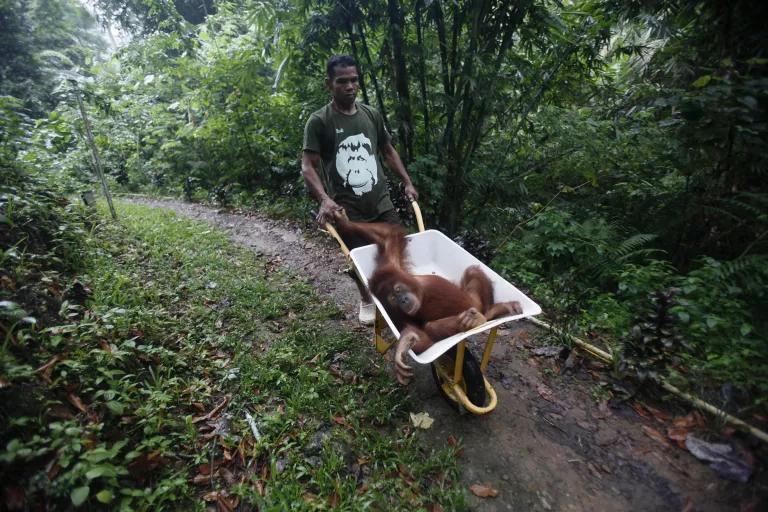
Globally, wildlife trade is the second-biggest threat to the vital biodiversity of our planet, following habitat loss. A recent study found that 958 species listed as at risk by the International Union for Conservation of Nature (IUCN) were in danger of extinction because they are being traded internationally. There are countless examples of species that have been decimated by wildlife trade, including elephants, rhinoceros, and pangolins.
This has devastating impacts not only on wildlife itself, but also on humans. In fact, many scientists assert that the destruction of nature is as dangerous to human life as climate change—and may threaten human life sooner than global warming—because it can result in cascading effects that reduce overall ecosystem functioning. Indeed, we depend on biodiversity, meaning a wide range of species existing together on the planet, for the healthy soil and crops that provide our food, the water we drink, the clean air we breathe, and the stability of weather patterns. An estimated four billion people also rely on natural medicines for their health care, medicines whose ingredients could be destroyed by a loss of biodiversity.
Illegal wildlife trade—what many refer to as “wildlife crime”—is also used to finance conflict and contribute to instability in countries that are already suffering. In Central African countries, such as the Democratic Republic of Congo, some armed groups raise funds by poaching and selling animals and lumber.
Destroying wildlife also has a severe economic impact on nations around the world. For example, logging and other forms of deforestation in Kenya threaten the country’s ability to grow tea, a product that brings in millions of dollars as an export industry.
Finally, the illegal wildlife trade spreads diseases and invasive alien species, which are plants and animals introduced by humans to areas outside their natural habitats. Both can have disastrous impacts on native wildlife and on humans. For example, smuggling animals across borders without proper inspection increases the risk of spreading diseases such as Ebola or bird flu. And the numbers of invasive alien species per country have risen by some 70 percent since 1970.
Examples of Highly Trafficked Species
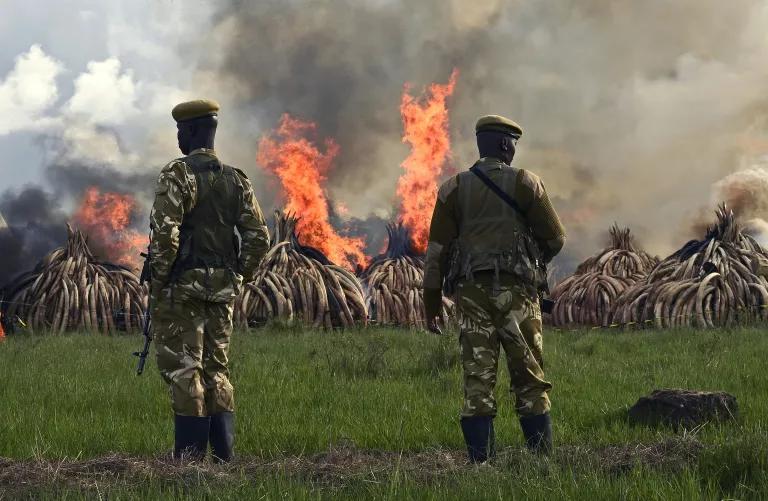
Elephants
Demand for ivory in Asia and among antiques dealers around the world for its aesthetic uses, such as in carved decorative items, has decimated the elephant population. There were about 1.3 million elephants in Africa in 1979. By 1989, that number had plummeted to 600,000, a direct result of the animals being killed for their tusks. That same year, CITES effectively banned the international trade of ivory to save elephants from extinction. However, the population crashed again little more than two decades later, with 100,000 elephants killed between 2010 and 2012. This was due to approved one-off sales of ivory stockpiles from African to Asian countries in 2008: The more legal ivory on the market, the more opportunities there are for passing illegal ivory off as legal, thus the increase in poaching.
Since this crisis, the global community has come together to save elephants by stopping the illegal ivory trade. Indeed, top ivory-consuming countries, including the United States, China, and the United Kingdom, have implemented domestic ivory bans over the past several years to complement the CITES ban on international trade. With legal markets closed, it is easier to enforce ivory restrictions, as poachers can’t pass off illegal ivory as legal. Further, many U.S. states—including the nation’s top three ivory markets of New York, California, and Hawaii—have enacted ivory bans to address intrastate trade (trade within the state). To ensure that the bans have teeth, local law enforcement is critical; in California, for example, the Department of Fish and Wildlife trains officers on the enforcement of ivory laws. People in the state caught selling ivory and rhino horn are now fined up to $50,000 in criminal penalties and $10,000 in civil fines. They also face up to a year of jail time.
A study of elephant populations suggests that African elephants are benefiting from such protections, but certain African countries still hope to legalize the international ivory trade under CITES for profit. What’s more, the volume of illegally traded ivory around the world between 2011 and 2016 was the highest level it has been in nearly three decades, and elephants continue to die from poaching more frequently than from natural causes.
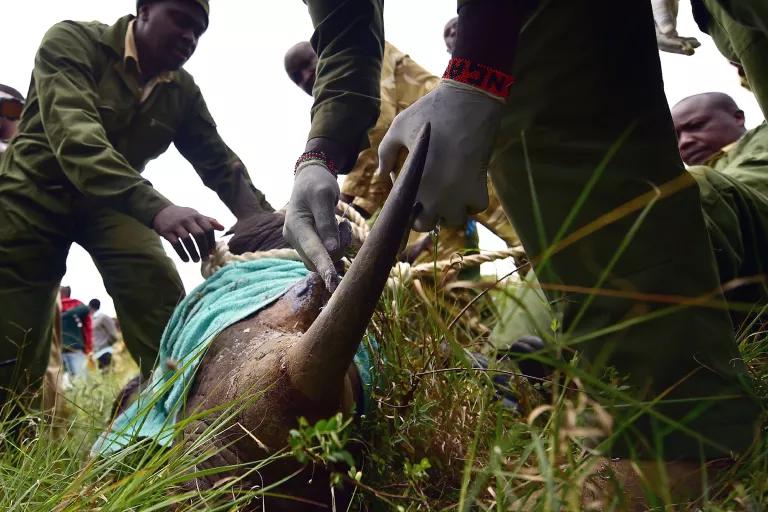
Rhinoceros
Rhino horns, touted to have medicinal powers, are among the most expensive substances on the planet. In reality, the protein that makes up rhino horn has no more potency than human fingernails, but its reputation, driving a wholesale market that may be worth a quarter of a billion dollars, has pushed the animals to the brink. All five species of rhinos are threatened with extinction, according to the IUCN, with four species listed as either endangered or critically endangered. Fortunately, rhinos are listed in CITES Appendix I, meaning trade in their horns is banned, with the exception of South Africa’s and Eswatini’s (formerly Swaziland) southern white rhino populations, which are listed in Appendix II to allow trade in live animals. Despite the plight of the species, some countries continually seek authority to trade in rhino horn.
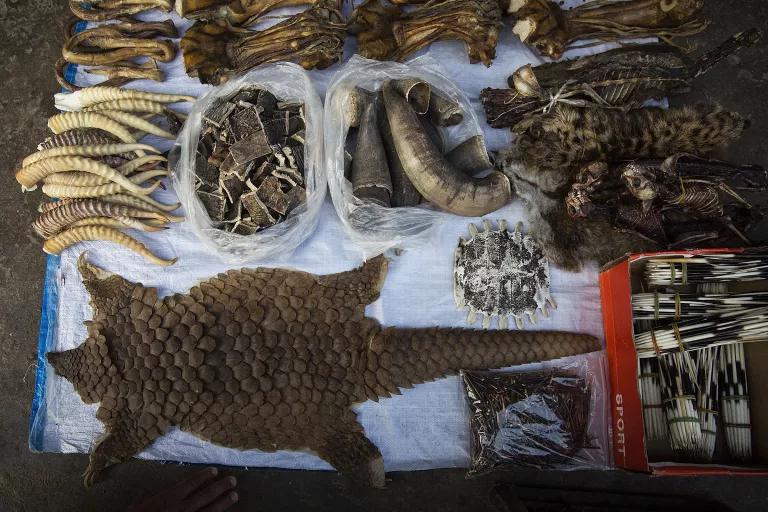
Pangolins
Pangolins, the scaly anteaters of Asia and Africa, are the most illegally traded mammal in the world. Indeed, a staggering one million pangolins are believed to have been taken from the wild over the past 15 years for their meat, which is consumed as a delicacy in Asian countries like China and Vietnam, and their scales, which are used in traditional medicines. In 2014, CITES voted unanimously to ban the international commercial trade in pangolins—all eight species of which are classified as threatened with extinction by the IUCN. However, despite the new Appendix I listing, the illegal trade continues, with seizures like a recent one in Singapore involving some 36,000 animals.
Stopping Wildlife Crime
A variety of national and international NGOs and national governments have prioritized tackling international wildlife trafficking. Some are on the ground in exporting and importing countries, stopping poachers and buyers in their tracks. Some are developing sophisticated technology to determine the precise origins of suspect wildlife products and identify poaching hot spots. Many are focused on educating the global population about the need to stop consuming endangered wildlife. Some, like NRDC, are advocating for policy changes—like domestic ivory bans and laws that make it easier to prosecute wildlife traffickers—in the United States and other countries and at the international level. Still other organizations help care for and rehabilitate highly endangered animals that have been confiscated from traffickers.
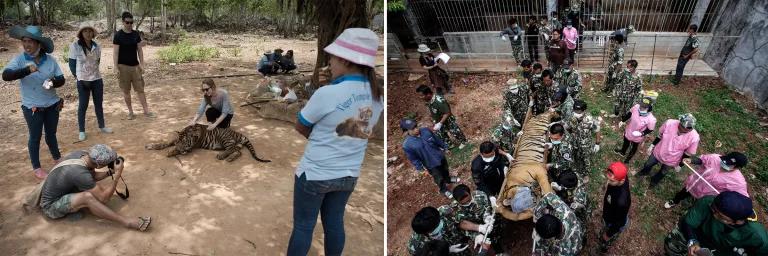
What you can do
- Never, ever buy animal products you suspect might be illegal.
- Before you buy a pet, research the sustainability and health issues associated with it; this database can help. For example, if the endangered Asian arowana fish is bred in captivity, it’s legal to trade in some countries in Asia, including Singapore, and the captive-bred fish are microchipped and certified to be sustainably raised. To support similar programs here in the United States, call your local pet supplier and ask what the company is doing to protect biodiversity and keep the pet trade sustainable.
- Support organizations like NRDC, which are fighting to save these animals.
- Contact your representatives in Congress to let them know that you are concerned about international wildlife trade and its contribution to biodiversity loss. Members of Congress have a direct line of communication with decision makers at the U.S. Fish and Wildlife Service, who have the authority to protect imperiled species both foreign and domestic. Further, members of Congress can pass legislation that offers additional ways to fight back against this crisis.
- While you’re at it, contact your state representatives with the same message. Legislation regarding imperiled species is often considered at the state level. We need all the help we can get fighting back against bills that erode species protections and building support for ones that help protect vulnerable species.
This NRDC.org story is available for online republication by news media outlets or nonprofits under these conditions: The writer(s) must be credited with a byline; you must note prominently that the story was originally published by NRDC.org and link to the original; the story cannot be edited (beyond simple things such as grammar); you can’t resell the story in any form or grant republishing rights to other outlets; you can’t republish our material wholesale or automatically—you need to select stories individually; you can’t republish the photos or graphics on our site without specific permission; you should drop us a note to let us know when you’ve used one of our stories.
These 5 Animals Would Be Goners Without the Endangered Species Act
What Are the Effects of Climate Change?
Biodiversity 101